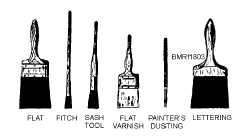Do not use gasoline, turpentine, mineral spirits,
or other solvents to remove paint from the skin,
as the skin will absorb them.
Follow the instructions of your supervisor
carefully.
PAINT ISSUE
Before paint is issued, several events must occur.
1. The division petty officer inspects the area to
make sure all preparations have been made. The petty
officer will check for the following:
Are all items not to be painted properly
identified or masked?
Are all safety precautions understood and
properly observed?
Is the surface ready to be painted?
2. Having checked out these items, you must fill
out the paint request; and describe the area to be painted,
including the paint color, type, and approximately how
much paint is needed. Completing the paint request chit
reduces the waste of materials and time spent redoing a
paint job. Your division officer may also inspect the area
to be painted before signing the paint chit.
3. The next step is the approval of the request by
the first lieutenant, who regulates the issue of paint.
As you can see, sometimes getting ready to paint
takes longer than the actual painting. Remember, if you
spill paint (oil, grease, and so on), you are responsible
for cleaning it up. At the end of working hours, return all
paint and brushes to the paint locker. Store the paint in
its proper container, and clean all brushes and rollers.
PAINTING
Three means of applying paint are used in the
Navy—brush, roller, and spray. The majority of Sailors
don’t use paint sprayers; therefore, they aren’t covered
in this section. However, you will learn about using
brushes and rollers to apply paint. Everyone in the Navy
should be familiar with these items.
Paint Application by Brush
Smooth and even painting depends as much on
good brushwork as on good paint. There is a brush for
almost every purpose. You should use the proper brush
and keep it in the best condition.
The two most useful brushes are the flat brush and
the sash tool brush. These brushes and some others
commonly used aboard ship are shown in figure 18-3.
With a flat brush, you can paint almost anything aboard
ship. Flat brushes are wide and thick. They carry a large
quantity of paint and provide a maximum of brushing
action. Sash brushes are handy for painting small items,
for cutting in at corners, and for hard-to-get-at spaces.
The fitch brush also is useful for small surfaces. The
painter’s dusting brush is used for cleaning surfaces.
The following are hints to help you use a paintbrush
properly:
Grip the brush firmly, but lightly as shown in
figure 18-4. Don’t put your fingers on the bristles below
the metal band (ferrule). The grip shown permits easy
wrist and arm motion. To hold it otherwise restricts your
movements and causes undue fatigue.
When using a flat brush, don’t paint with the
narrow edge. This practice wears down the corners and
spoils the shape and efficiency of the brush. When using
an oval brush, don’t revolve it too much or it soon wears
to a pointed shape and becomes useless. Do not poke
oversized brushes into corners and around moldings.
Such a practice bends the bristles, eventually ruining a
good brush. Use a smaller brush that fits into such odd
spots.
Dip the brush into the paint, but not over halfway
up the bristles. Remove the excess paint by patting the
brush on the inside of the pot. (Avoid overfilling the
18-17
Student Notes:
Figure 18-3.—Types of brushes.



